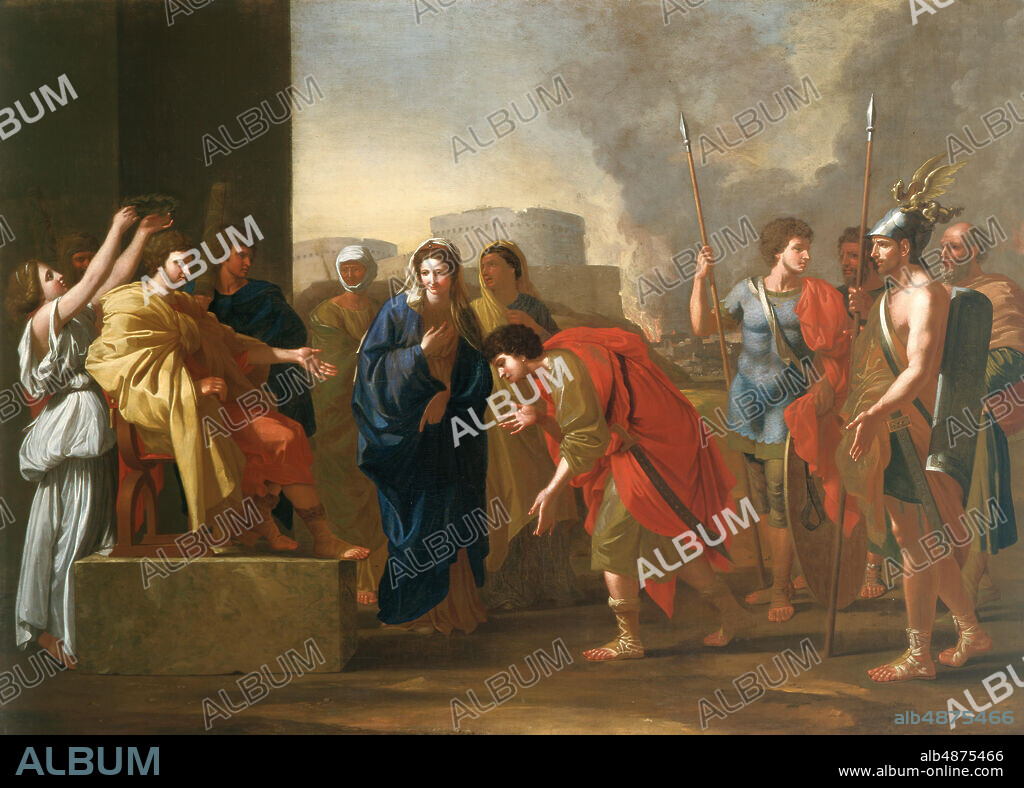alb4875466
John Smibert, The Continence of Scipio, ca. 1719-1722, oil on canvas, 45 3/4 in. x 62 5/8 in. (116.21 cm x 159.07 cm), Smibert's painting is a copy of a 1640 painting by the revered French painter Nicolas Poussin. Its subject derives from Roman history. During the Second Punic War, the Roman general Publius Cornelius Scipio Africanus decided to return his war spoils, including the bride of his enemy Allucius, the young prince of the Celtiberians. Scipio's moral fortitude presented an ideal subtext for Poussin's classical interpretation. John Smibert, the copyist, was a portrait painter from Scotland who trained in London and later set out with Dean George Berkeley to found a college in Bermuda. This painting was intended to be part of the college's teaching collection, but when that project fell through, Smibert exhibited it in his Boston studio and art supply store. In Boston it set an example for John Singleton Copley, who admired it. At Bowdoin College since James Bowdoin III's bequest in 1813, the work has contributed to the education of countless generations of students.

|
Añadir a otro lightbox |
|
Añadir a otro lightbox |



¿Ya tienes cuenta? Iniciar sesión
¿No tienes cuenta? Regístrate
Compra esta imagen

Descripción:
Traducción automática: John Smibert, La Continencia de Escipión, ca. 1719-1722, óleo sobre lienzo, 45 3/4 pulg. x 62 5/8 pulg. (116,21 cm x 159,07 cm), la pintura de Smibert es una copia de una pintura de 1640 del reverenciado pintor francés Nicolas Poussin. Su tema deriva de la historia romana. Durante la Segunda Guerra Púnica, el general romano Publius Cornelius Scipio Africanus decidió devolver su botín de guerra, incluida la novia de su enemigo Allucius, el joven príncipe de los celtíberos. La fortaleza moral de Escipión presentó un subtexto ideal para la interpretación clásica de Poussin. John Smibert, el copista, era un pintor de retratos de Escocia que se formó en Londres y más tarde partió con Dean George Berkeley para fundar una universidad en las Bermudas. Esta pintura estaba destinada a ser parte de la colección de enseñanza de la universidad, pero cuando ese proyecto fracasó, Smibert la exhibió en su estudio y tienda de artículos de arte de Boston. En Boston fue un ejemplo para John Singleton Copley, quien lo admiró. En Bowdoin College desde el legado de James Bowdoin III en 1813, el trabajo ha contribuido a la educación de innumerables generaciones de estudiantes.
John Smibert, The Continence of Scipio, ca. 1719-1722, oil on canvas, 45 3/4 in. x 62 5/8 in. (116.21 cm x 159.07 cm), Smibert's painting is a copy of a 1640 painting by the revered French painter Nicolas Poussin. Its subject derives from Roman history. During the Second Punic War, the Roman general Publius Cornelius Scipio Africanus decided to return his war spoils, including the bride of his enemy Allucius, the young prince of the Celtiberians. Scipio's moral fortitude presented an ideal subtext for Poussin's classical interpretation. John Smibert, the copyist, was a portrait painter from Scotland who trained in London and later set out with Dean George Berkeley to found a college in Bermuda. This painting was intended to be part of the college's teaching collection, but when that project fell through, Smibert exhibited it in his Boston studio and art supply store. In Boston it set an example for John Singleton Copley, who admired it. At Bowdoin College since James Bowdoin III's bequest in 1813, the work has contributed to the education of countless generations of students.
Crédito:
Album / quintlox
Autorizaciones:
Modelo: No - Propiedad: No
¿Preguntas relacionadas con los derechos?
¿Preguntas relacionadas con los derechos?
Tamaño imagen:
7128 x 5116 px | 104.3 MB
Tamaño impresión:
60.4 x 43.3 cm | 23.8 x 17.1 in (300 dpi)
 Pinterest
Pinterest Twitter
Twitter Facebook
Facebook Copiar enlace
Copiar enlace Email
Email
